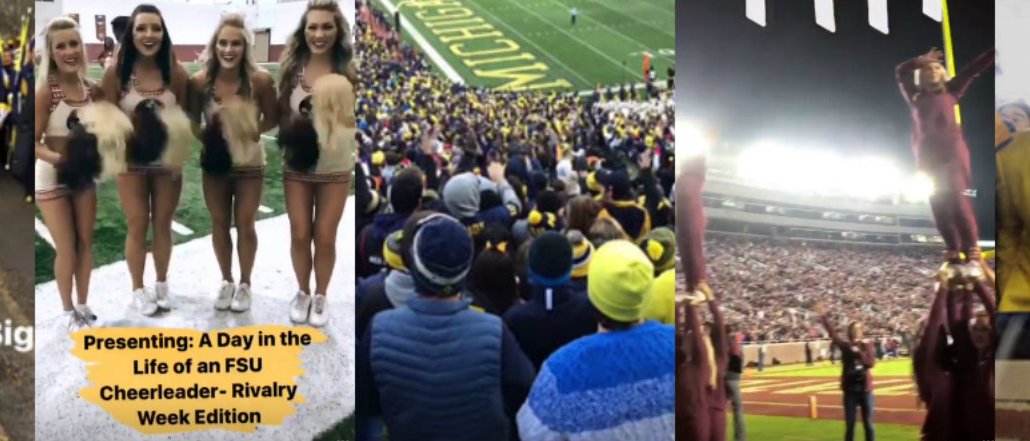How Instagram recruits college football teams to market Stories

On Saturday, Nov. 19, the day the Michigan Wolverines’ football team played the Indiana Hoosiers, Michigan undergraduate student Katie Hartwig was given an interesting job: She was to takeover the Michigan Athletics Instagram account and provide a behind-the-scenes look at the atmosphere surrounding the game by using one of Instagram’s newest features, Instagram Stories.
Hartwig ended up publishing 15 photos, videos and looping Boomerang shots that day. This included shots of the various tailgates; of fans, cheerleaders and the band walking to the stadium; and even a shot of “Go Blue!” that she personally wrote in the snow. Available to anyone following the Michigan Athletics account, the story averaged 10,000 views per post, according to Keith Bretzius, digital director of Michigan’s athletic department.
Chalk up a success for Instagram’s internal new “correspondents program,” which involves getting big-time college football programs to use Instagram Stories on game days through the rest of the year. In addition to Michigan, other schools participating in the program include Ohio State, Florida State, Clemson, Colorado, Washington and California. The correspondents program will culminate at the national title game, during which one of the correspondents will be chosen by Instagram to take over the main Instagram account and create a story for its 200 million followers.
Instagram isn’t paying colleges to create the content. Instead, it is acting more as evangelists for the product — and how college sports teams can use it to build enthusiasm with their fans.
For the program, it’s up to the school to choose its correspondent — for instance, Hartwig was chosen by Michigan because she’s an intern within its athletics department; Ohio State recruited Adam Watson, a fourth-year finance major from an on-campus student fan group called Block “O”; and Florida State had one of its cheerleaders take over the school’s account.
“With the Instagram Stories program, we were able to show fans game day through a different lens,” said Aaron Green, emerging media specialist at Ohio State Athletics, which employed the feature during the big Michigan-Ohio State rivalry game this past weekend.
While Clemson has experimented with Instagram Stories on its various team accounts, the correspondents program was the reason why Clemson created Instagram Stories content on its main account, according to Jonathan Gantt, director of new and creative media for Clemson Athletics.
By participating in the program, the schools receive support and training from Instagram. For instance, Instagram set up a Google Hangouts session with Michigan Athletics to go over new features that were coming to Instagram Stories and to ensure the department was familiar with all aspects of the product.
If all of this sounds familiar, it’s the same exact playbook Facebook employed when it rolled out Facebook Live. Earlier this year, Facebook directed its partnerships teams — across news, sports and entertainment, among other departments — to encourage publishers to experiment with live video. This included dozens of March Madness teams.
“Anytime there are new social tools out there, if you’re able to get that personal touch, direction and support from the platform, we’re much more likely to use that tool and work with that organization,” said Bretzius.
It worked for Facebook Live, and it will likely be the same story for Instagram Stories. In addition to these colleges, Instagram is also assisting media companies including CBS, Bleacher Report and National Geographic on Instagram Stories. The advantage of these partnerships is they act as marketing without actually being paid-for marketing, giving it a certain amount of grass-roots feel.
“It’s a smart way to evolve the Stories by using the Instagram community to develop their own version of [Snapchat’s] Live Stories, as opposed to paying an editorial staff to do it,” said Jason Stein, CEO of digital agency Laundry Service and sports publisher Cycle. “It could make every school that’s not part of the program use Instagram Stories.”
Instagram’s approach is the exact opposite of how Snapchat works with publishers. While Snapchat has Discover and Live Stories to feature content made by publishers, the app is closed off to most of the media world.
“Not everyone can get on to Snapchat Discover or Live Stories, whereas with Instagram Stories, everyone can do it and be successful,” said Stein. “It’s more democratic and less of a kingmaker platform. That’s a really strong position for Instagram.”
More in Media

Here are the biggest moments in AI for publishers in 2025
Here are some of the moments that defined how publishers adapted to the AI era this year.

Digiday+ Research roundup: Gen Z news consumption and diversification in the DSP space were 2025’s top trends
As 2025 winds down, we rounded up the biggest trends of the year, based on the data that resonated the most with Digiday’s readers.

What publishers are wishing for this holiday season: End AI scraping and determine AI-powered audience value
Publishers want a fair, structured, regulated AI environment and they also want to define what the next decade of audience metrics looks like.








